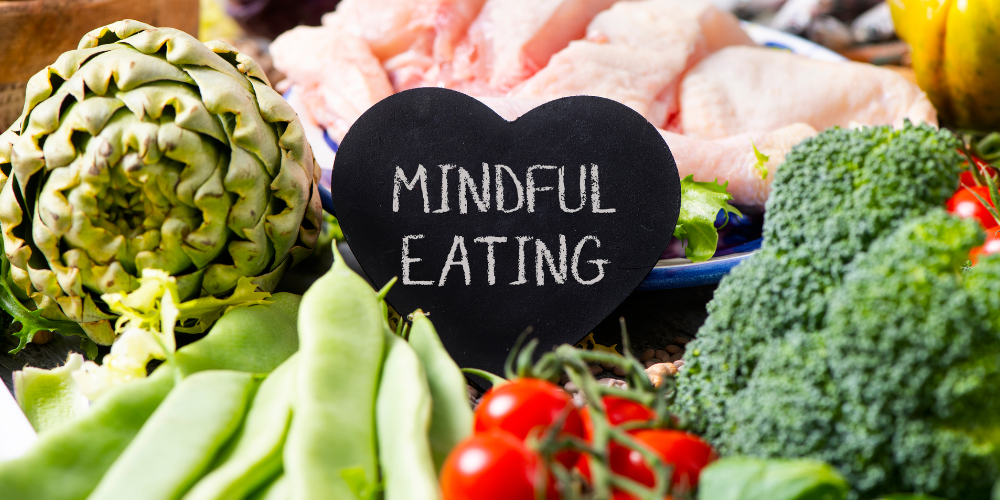Mindful eating ain’t just another buzzword floating around wellness circles. It’s about tuning into your eating experiences—being fully present and aware during meals. But what does that really mean? Imagine savoring each bite of chocolate like it’s a VIP experience. That’s mindful eating, my friends.
The idea is simple yet revolutionary: transforming your eating habits by being present. This concept might seem fresh, but it’s deeply rooted in ancient mindfulness practices, particularly from Buddhism. When you dive into mindful eating, you’re tapping into a centuries-old tradition. It’s all about slowing down and appreciating food beyond just the taste—considering texture, aroma, and even the looks of your meals.
In a world where grabbing a to-go meal while rushing to your next meeting is the norm, mindful eating stands its ground as a powerful way to reclaim your relationship with food. Simply put, it’s about tuning out the noise—those endless notifications and distractions—and paying attention to what you’re putting into your body.
Why does it matter today, especially when life moves at the speed of a tweet? In this hustle-bustle era, losing touch with our meals is common. We eat because we have to, not because we want to, to appreciate the food on our plates. Mindful eating rewinds that pattern, encouraging us to savor our meals, recognize our hunger cues, and make eating a more conscious act.
Mindful eating may be the key to a healthier, more balanced life, helping us better understand our body’s needs and fostering a positive relationship with food. So, next time you’re ready to chow down, take a moment. Enjoy that food for what it is, and maybe, just maybe, you’ll find something to savor.
Dispelling Common Misconceptions About Mindful Eating
Mindful eating is often misrepresented in conversation, leading to some widespread misunderstandings. One biggie is thinking about mindful eating as just another type of diet. Unlike diets that dictate what you can or can’t eat, mindful eating encourages you to tune into your body’s signals, helping you to decide when and what to eat without restrictions or guilt.
Another misconception? It’s not only about eating slowly. Sure, taking your time with meals is part of the package, but there’s more to it. Imagine diving into the sensory details, from the crunch of a carrot to the rich aroma of a stew. The real challenge and delight in mindful eating is to engage all senses with each bite thoroughly.
The confusion often intensifies when you add intuitive eating to the mix. While both approaches emphasize listening to your body, mindful eating is more about being present in the moment—the act of eating itself. Intuitive eating, on the other hand, extends beyond meals, guiding you towards understanding and respecting your body’s unique hunger and fullness cues in everyday life.
By clearing up these misconceptions, we can focus on the real goal here—changing our attitudes towards food and our bodies. When you break it down, mindful eating isn’t about strict rules or limitations. It’s about freedom and understanding, so you make choices that truly align with what your body needs.
The 5 S’s of Mindful Eating: A Step-by-Step Approach
Mindful eating might feel like a lot to chew, but breaking it down into five easy steps—the 5 S’s—makes it way easier to digest. Starting with ‘Savor.’ Ever watched a kid eat ice cream like it’s the best thing ever? That’s savoring in its purest form. Enjoy every bite as if it were a new culinary journey.
Next up, ‘Slower.’ In a world that tells us faster is better, slowing down at mealtime might sound like a radical move. But sometimes, putting your fork down and just taking a breath between bites is all it takes to really feel satisfied.
‘Simplify’ is about cutting down the chaos around you when you eat. That means putting away your phone, turning off the TV, and simply being present with your food. It’s hard to truly connect with your meal if your mind’s glued to a screen.
Then there’s ‘Selection.’ This one’s about being a conscious shopper and eater. Think before you pick that packaged snack, considering if it’s really what your body needs right now.
Finally, ‘Smile.’ Building a positive relationship with food is all about how it makes you feel, not just while you’re eating, but also after. Food should be enjoyable, not just fuel. Remind yourself that eating can be a joyous part of your day.
The Challenges of Eating Healthy: What’s Holding Us Back?
Eating healthy seems straightforward until life gets in the way. One of the biggest hurdles is time. Between work, family, and social commitments, whipping up a wholesome meal can feel like a luxury. Instead, we often reach for convenience foods that prioritize quick fixes over nutrition.
Then comes the cost factor. Let’s be real—buying fresh, organic produce can be a costly endeavor. It’s a little unfair how junk food often comes cheaper and lasts longer, tricking us into thinking we’re making the wise choice when, health-wise, it’s anything but.
And don’t even get me started on the world of processed foods. They’re everywhere, meticulously packaged and aggressively marketed to scream “buy me now!”—pushing sugary cereals or salty snacks front and center. At the same time, the kale quietly chills in some desolate corner of the store.
These challenges would make anyone’s head spin, but they underline why mindful eating isn’t just a trend—it’s a way to regain control in a food landscape that’s often overwhelming. It prompts us to pause, ponder, and potentially change the narrative around not just eating, but nourishing ourselves on our own terms.
Exploring the Disadvantages of Intuitive Eating
Intuitive eating is often paired with mindful eating, but it has its own set of challenges. One challenge is an over-reliance on listening to your body’s signals. While following hunger cues sounds straightforward, our internal systems can become confused by emotions—such as stress —leading to cravings for cookies, making it hard to trust those signals completely.
Balancing internal cues with sound nutritional knowledge is another task. While tuning into what you feel like eating is essential, it doesn’t replace understanding dietary needs. Grappling with this can lead to missteps, like ignoring your body’s call for more fruits and veggies because a pile of fries seems more appealing in the moment.
There’s also the risk of misinterpreting hunger cues. Distinguishing between actual hunger and, say, boredom-induced hunger requires practice and patience. It’s easy, especially when starting out, to mistake emotional needs for physical hunger, which can lead to overeating or undereating.
Despite these hurdles, intuitive eating remains a valuable tool for fostering a positive relationship with food. It champions a more holistic view of eating—one that encourages you to look beyond diet constraints and focus on the broader picture of well-being.
Mindful Eating and Its Relationship with Nutrition Science
Mindful eating isn’t here to discard nutritional science. Instead, it’s like a buddy that enhances your understanding of how nutrition affects you personally. By combining mindfulness with what science suggests about balanced meals, you can make choices that are both thoughtful and informed.
While dietary guidelines provide a solid foundation, examining them through a mindful lens may help you better appreciate the rationale behind these guidelines. It’s about forming a partnership between mindfulness and nutrition that allows you to tune into what your body truly needs at a given moment.
Mindfulness can play a pivotal role in weight management and overall well-being. By paying attention to your body’s hunger and fullness signals, you may become more aware of when you’re eating for nourishment versus when you’re eating to manage emotions or combat boredom.
Ultimately, mindful eating supports nutritional science by turning abstract dietary principles into practical, daily habits. When what’s on your plate isn’t just food but a part of a bigger lifestyle choice, eating becomes more than just a necessity—it becomes a way of caring for yourself, inside and out.
Public Perceptions and Cultural Biases: A Realistic View on Mindful Eating
Mindful eating isn’t just a singular practice; it dances with cultural norms and traditions, making it quite the chameleon. Depending on where you’re coming from, how you embrace this approach can be shaped by a tapestry of cultural influences. In some places, leisurely meals filled with conversation naturally reflect mindfulness, without the need for a label.
Western cultures often have a more mechanical way of eating—think fast food and quick bites as we multitask through our days. In contrast, Eastern traditions might naturally embrace mindfulness, with deep-rooted practices that value the act of dining as a sacred and slow experience. These diverse perspectives create unique understandings and applications of mindful eating.
Media and marketing also stir the pot, sometimes portraying mindful eating as elitist or unattainable—like it’s reserved for those with ample time and resources. However, the essence of mindfulness is simplicity and accessibility, reminding us that anyone, anywhere, can practice mindful eating, regardless of their background.
Recognizing these cultural biases allows us to approach mindful eating with an open mind. Instead of getting caught up in idealistic portrayals, focusing on how mindfulness can be integrated into our lives—and understanding that everyone’s mindful eating journey may look a little different—frees us to explore what works best for each individual.
Embracing Mindful Eating: Practical Tips and Strategies
Bringing mindfulness into your eating routine doesn’t need to be earth-shattering. Start by setting the stage. When you sit down for a meal, aim to clear your mind of clutter and focus on the present moment. Ditch the distractions like phones or TV to be truly present with your food.
Tackling barriers is easier when you know what you’re up against. If time’s a factor, carve out even a few minutes of undistracted eating. Permit yourself to slow down, savoring not just the food but the break from the day’s hustle. Shop smart by planning your meals; it steers you clear of impulsive snack runs.
Real-life stories can be incredibly motivating when you’re starting with mindful eating. People who’ve embraced mindfulness often talk about more explicit hunger recognition and a newfound appreciation for meals. It’s not about perfection but progress—learning to listen to your body and making tweaks along the way.
So, as you embark on this journey, remember to be kind to yourself. Mindful eating isn’t a strict regimen, but a flexible, ongoing process of discovery that helps you connect with food in an intentional and meaningful way.

